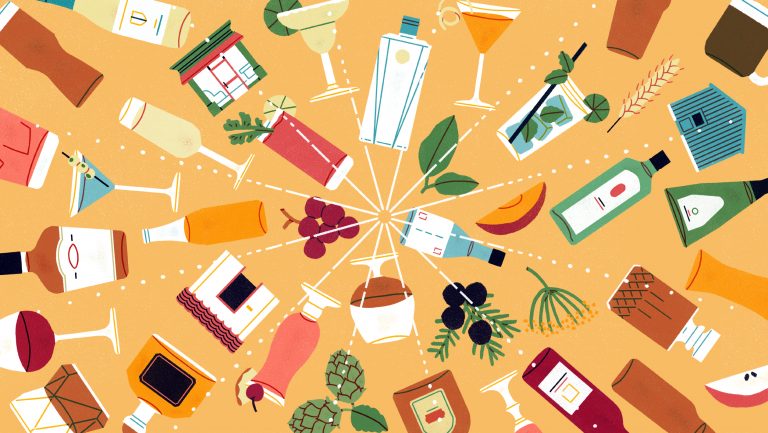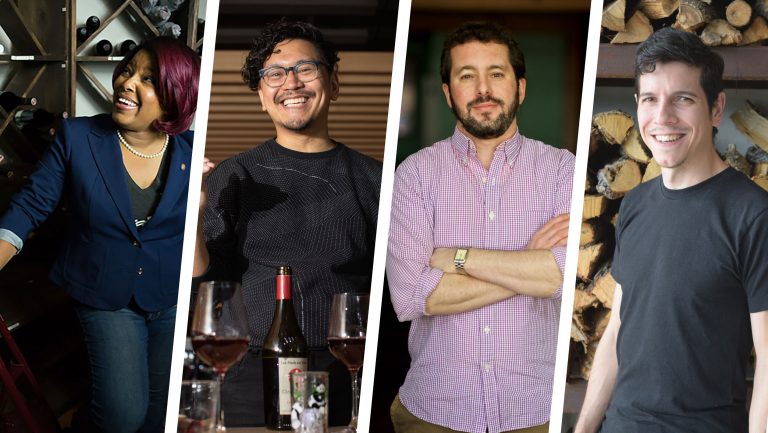[ad_1]
As frequent fixtures of high-end, tasting menu-driven eating places throughout the U.S., coursed wine pairings may be tough to handle. Although they provide a simple solution to get wine in visitors’ glasses, preselected pairings can develop into rote, create waste, and even be financially unsuccessful if a beverage director isn’t cautious—concerns that at the moment are extra vital than ever.
When accomplished nicely, nevertheless, coursed wine pairings can profit each restaurant operators and visitors. The crew at Portland, Oregon’s Le Pigeon eradicated their à la carte menu and moved totally to a tasting menu in 2020, which permits the restaurant to seat fewer visitors amidst COVID-19 precautions and make sure that every desk will meet a sure income minimal—one thing that wine pairings issue into as nicely.
“It means that you can work out your pricing, price, and bills based mostly on a collection of wines, not one explicit bottling,” says Andy Fortgang, Le Pigeon’s co-owner and wine director, noting that it additionally permits him to optimize stock. “For our reserve pairings, it lets us go into the cellar and say, ‘We now have three or 4 bottles of this, let’s pour this wine for 2 or three nights.’”

Don’t miss the newest drinks trade information and insights. Join our award-winning Every day Dispatch e-newsletter—delivered to your inbox each week.
SevenFifty Every day requested six sommeliers and beverage administrators how they handle the logistics and profitability of coursed wine pairings, with the purpose of figuring out greatest practices for working a set wine-pairing menu whereas protecting choices fascinating and cost-effective.

Keep on with a set worth.
Mounted-price pairings—reasonably than name-your-price pairings—are sometimes simpler to handle, from the operations aspect, and simpler to know, from the visitor’s perspective. “Mounted costs assist to handle expectations for the visitor,” says Leslie Hartman, previously the sommelier at The French Room on the Adolphus Resort and now the overall supervisor at Clay Pigeon in Dallas. Nevertheless, providing a premium pairing along with the usual pairing creates extra alternatives for the sommelier to introduce particular wines to visitors. Le Pigeon gives a regular wine pairing for $50 and a reserve pairing for $75.
Search steadiness to attain profitability.
Fortgang approaches fixed-price pairing menus with a mean bottle price in thoughts, usually balancing higher-end pours with extra value-oriented ones. “We are able to take a much bigger margin on one and a smaller margin on one other,” he says, “and we’re nonetheless at that very same ultimate share.”
Having a goal price common can be useful if a sommelier is substituting a particular pairing for a specific visitor. Jennifer Wagoner, the group wine director at Zuma Restaurants, which has places world wide, notes that it’s vital to view price as a transferring goal. “It could enhance and reduce over the course of a month,” she says. “It’s vital to know that variation so that you’re sustaining a workable price.”
By-the-glass wines decrease waste and supply worth—when priced accurately.
Whereas Pinch Chinese in New York Metropolis has a sliding-scale pairing referred to as “Somm’s Selection,” many of the pairings bought fall underneath one among their fixed-price pairing choices: Home ($25) and Quick ($35). For each, basic supervisor and wine director Miguel de Leon leans on his by-the-glass record however works with suppliers to ship nice worth to visitors. “The bottles are often at their deepest case breaks, or within the case of our partnership wines, at a worth we’ve negotiated prior,” he says.
For Fortgang, transferring to a pairing menu at Le Pigeon has improved the standard of the by-the-glass record, since the usual pairings all come from the by-the-glass record. “We’re pouring barely dearer wines than we had been earlier than,” he says. “But it surely’s vital to concentrate on what you’re charging for the pairings. If they’re on the by-the-glass menu, somebody’s going to do the mathematics.”
Add worth with offbeat choices.
When charging a set worth for wine pairings, it’s vital that wine administrators hunt down wines that overdeliver for his or her worth factors. “That is the place actually fascinating, esoteric wines may help you out,” says Alisha Blackwell-Calvert, a positive wine marketing consultant and former sommelier at Elaia in St. Louis, who appears to bottles from Croatia, Greece, and Portugal because of this. “The bizarre, artistic stuff is often cheaper.”
Lesser-known wines additionally add worth by showcasing new discoveries or information to visitors, and so they may help make sure that a restaurant’s wine pairings are in keeping with its total wine program ethos. “An important factor for us to strike the steadiness of underpromise and overdeliver, so a good bit of homework goes into looking for underrepresented grape varieties, non-traditional winemaking strategies (like must-mixing, co-ferments, or piquettes), undervalued areas, and ensuring we’re a spot that’s for entry whereas sustaining curiosity,” says de Leon.
Talk with the kitchen.
As a result of fixed-price pairings go hand in hand with the dishes on a tasting menu, it’s important to constantly talk with the kitchen concerning the menu. “There are wines which will carry out totally different sides of the dishes,” says Wagoner. “The choices are limitless, and it’s enjoyable to combine it up.”
Not solely will this enable the beverage director to curate extra profitable pairings, however it might save stock complications; Stefan Davis, the overall supervisor of Barley Swine in Austin, Texas, remembers reordering a wine that was paired with a tasting dish solely to study that the chef had taken the dish off the menu that day. “My recommendation to anybody desirous about executing a pairing menu,” he says, “is to hitch the kitchen assembly so that you’ve got an up-to-date projection on what dishes are altering and when.”
Keep away from waste by getting artistic.
If a restaurant has a dependable variety of visitors who go for fixed-price, preselected pairings, waste shouldn’t be a problem. But when a sommelier swaps out a pairing for a specific visitor, or reservations occur to lag for a couple of days, it’s time to get artistic. Hartman would keep away from opening up a full bottle if the restaurant was closed the subsequent day by opening a half bottle or utilizing a Coravin to serve a pairing late on a Saturday night time; she recommends protecting a chart of all pairings in progress to anticipate how a lot of the pairing wines might be poured every night time.
Extra typically, beverage administrators will try and promote a one-off open bottle by the glass. “[When I was at Sepia and Proxi in Chicago], if we opened a bottle for a particular pairing, we regularly would run a glass particular for that night time till it was gone,” says Wagoner. When Blackwell-Calvert was at Elaia, she had the good thing about having a second operation at her disposal; on the extra informal Olio, which is linked to Elaia, she bought leftover pairing-menu wines as by-the-glass choices. Hartman suggests internet hosting a casual employees coaching to make use of an unsold open bottle as an academic alternative.
Be versatile to accommodate visitors.
Whereas having set pairings for a menu could make each funds and stock extra manageable, it’s vital to remain versatile. Hartman has curated pairings of all white wines or all American wines when requested to, as an illustration, whereas Blackwell-Calvert as soon as paired a shellfish-heavy menu totally with purple wines, at a visitor’s request. Davis will typically customise the set pairings if the kitchen should substitute a dish for a visitor’s allergy, since he needs the pairing to work nicely with the meals.
Typically, although, the success of a pairing comes all the way down to hospitality. “Often there are visitors who style a wine and don’t take care of it,” says Hartman, “however I’ll clarify why the wine was chosen to enrich the dish, and upon tasting the 2 collectively, they’re often happy.” She will recall solely two occasions when a visitor actually didn’t just like the wine, and she or he fortunately poured the particular person one thing else.
Use wine pairings to reinforce the visitor expertise.
When accomplished nicely, wine pairings create a particular hospitality expertise for visitors as a result of the sommelier or server is extremely engaged with the desk, every glass is chosen to enrich the flavour of every dish, and visitors come away with new wine information. “It permits for a extra immersive expertise of hospitality: we’re taking good care of every part, and we imply it,” says de Leon.
“The visitors are getting a greater worth, and it’s nice for our backside line,” provides Fortgang. He notes, nevertheless, that so as to ship on that glorious visitor expertise, there have to be sufficient wine crew members to pour every pairing as the brand new course arrives, or each crew member must know the wines in-depth.
Courtney Schiessl Magrini is a Brooklyn-based wine journalist, educator, and marketing consultant who has held sommelier positions at a few of New York’s prime eating places, together with Marta, Soiled French, and Terroir. She is at the moment the senior editor for SevenFifty Every day, and her work has appeared in Wine Fanatic, GuildSomm, Forbes.com, VinePair, EatingWell Journal, and extra. She holds the WSET Diploma in Wines and Spirits. Comply with her Champagne-fueled adventures on Instagram at @takeittocourt.
[ad_2]
Source link







